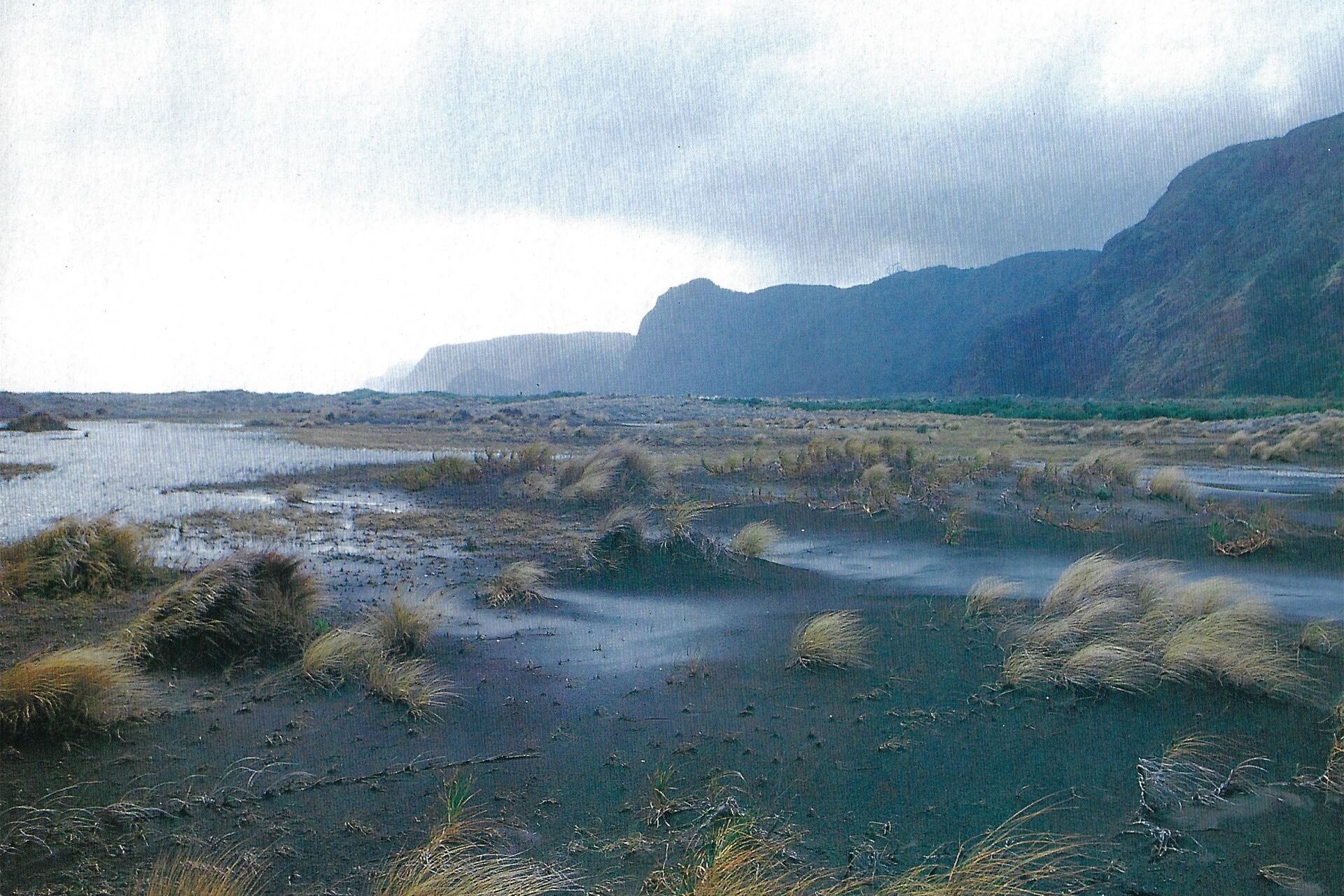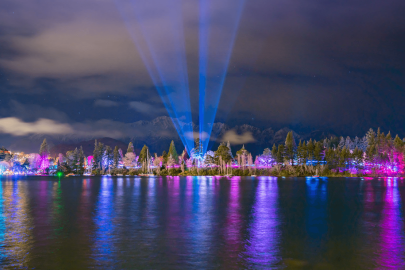Apr 8, 2024 Travel
The Whatipu sands have changed dramatically in the 30 years since Metro visited. It’s more dramatic, more raw if that is possible. It’s now a vast water wetland. The bird life is extraordinary. The walk up to Wing Head is an easy but steep climb — a set of stairs cut into the Omanawanui track takes you to new heights to view The Bar below. The Pink Lady ghost still haunts the old Whatipu Lodge guest house and the walk to the giant Cave of Legends and Dances is an easy but damp walk from the car park. The beach has been the setting for the epic new film The Convert set in 1830. An early New Zealand settlement was created between Wing Head and Paratutae Island. In Winter it’s still an exhilarating adventure close to Auckland.
Bob Harvey
Archivist
—
It was here that Kupe, the greatest of all Polynesian explorers, made a sacrifice on his journey south, Aunt Daisy holidayed, the legendary gold of the Orpheus lies buried, and for a mere $15 a night you can stay in a 130-year-old mill boarding house where time stands still. BOB HARVEY goes to Whatipu.
At the entrance of the Manukau Harbour is a remote and remarkable landscape where time, legends and history are interwoven, where an overwhelming sense of place staggers the senses. Its grandeur is unsurpassed on the west coast, and yet few Aucklanders dare the rough, unsealed, boulder strewn, cliff-hugging narrow road over Mt Donald Maclean at the northern tip of the Manukau.
To reach Whatipu, take the Huia road from Titirangi. Past Huia itself the road rises steeply from the Manukau. Here is the grand and colossal start of the Waitakere Ranges. The sea cliffs heave out of the vast ocean and the hills commence their journey northward.
At the top of the hill, you first glimpse Whatipu with its vista of the Manukau bar stretching 20 kms out to the Tasman, the most treacherous of all the west coast bars. Even on calm days the sea round and over the bar is never still.
Here was once New Zealand’s Atlantis. This now undersea landscape, destroyed finally in the great storms of 1936, extended 10 miles out into the sea, covered in lush bush, clumps of manuka and flax, consisting of small fishing villages dating back to Kupe’s time around 925 AD. Called Paorae, forever rich in seafood, the whole area is now engulfed and vanished under the incessant rollers. The surviving sentinel is the Ninepin Rock which stands solitary in the centre of Whatipu beach — Toka tapu a Kupe.
It was near this rock on February 7 1863, that the longboat of the Orpheus brought ashore some of the ship’s records before returning to the doomed vessel, hopelessly stuck and without any chance of survival, on the extreme tip of the middle bank three kilometres from the beach.
Around this tragedy, legends have grown — that the long boat carried bullion, gold to pay the soldiers in the land wars, bullion which is still reputed to be buried in the sand near the rock.
During the afternoon, the 1700 ton vessel, powered by a combination of sail and steam became a total wreck as the huge swells swept its deck, toppling the masts and drowning 189 of its officers and crew: The wreck of the Orpheus would remain New Zealand’s worst sea disaster. In the morning, only a few ribs and the stump of the maSt would record the ship’s passing.
Still, it was one of many. Over 60 vessel”s would founder on the Manukau bar, strewing bodies and wreckage along the strip of coast known as Taranaki Bay. Relics of the wrecks still surface today – spars and Indian teak beams, copper bolts and rigging pulleys. Many are on display in the Huia museum.

The Seascape at Whatipu is dominated by the white-capped bar for as far as the eye can see. As large coastal vessels move slowly down the middle channel, they appear as in a mirage to be sliding through the black iron sand dunes that surround the harbour.
It’s a hell of a place. In the summer of 1987 I was one of three swimmers who swam the heads from the south head to Destruction Gully, probably the first Pakeha crazy enough to do it. The Maoris would have done it because of necessity – flight or fight – there would be no other sensible reason for such an act. Admittedly we picked the right tide – if there is ever such a thing at the Manukau Heads — for our swim, but the force and the fury of the water in the middle channel was unabating, its sense of menace more than memorable. Swim only on the calmest days, staying close inshore and never on the coastal sweep northwards.
To greet you at the road’s end is the Whatipu Lodge on the grass bank above the car park, an establishment dating back to the 1860s. It was built by the Gibbons family who built and ran the mill in the lush valley behind the house.
Neal and Mary Roberts left their respective careers – he an engineer and she a nurse – five years ago to run the lodge, which, I think, is one of the great getaway places near Auckland. With 18 small but neat rooms, it sleeps 35 people for the amazing price of $15 a night for adults and only nine for kids. You’ll need to book in advance, but it’s well worth it.
The lodge and cabins are mostly original, the main section having been built in the mill’s heyday. A new wing was added in 1910. The pit-sawn kauri boards are all, of course, local and weathering well considering their age.
Some people have been coming back to the Whatipu Lodge for 30 years. For those who prefer to rough it, there’s a camping ground close by, which over the Christmas period takes around 200 people. Because the Whatipu fishing is still more than reasonable, you’ll find 50 people camped there year round. The Whatipu Lodge held the world record of a 3 7 pound kingfish in the 30’s; and the good news is they’re still pulling them in today, although they’re nowhere near the record weight.
In the last century and until the 1920s, the Whatipu beach area was the timberyard of New Zealand. Acres of sawn timber were stacked along the beach waiting for transport down the Manukau to Onehunga, or to be taken by scow or barge to build the cities of Wellington, Christchurch and Dunedin. The Waitakere Ranges were clothed in a great green forest, and rising sheer above the landmass, the great kauris. And kauri was king.
From the Anawhata and Piha gorges, snaking along the sea cliffs, came the bush mill rail trams. Constantly battered by Tasman rollers and operable only at low tide, the bush mill’s rail fed the wharf landing. Now only the odd sleeper and rusty spike mark the track.
In the late 1970s, a bunch of well meaning but totally insensitive rail enthusiasts from South Auckland attempted what has appeared to many environmentalists to be one of the most bizarre schemes ever to re-create a slice of bush mill history – to rebuild the tram rail from Whatipu to Karekare and beyond. Paying scant heed to concerned voices, they have continually battled to obtain permission and funding for this unusual venture. Such are their clandestine manoeuvres and determination, that they have over the years secretly built many of the proposed rail junctions and sections of mill trams, and the trestles to carry the rail over the sea gaps.
Nature, at its strongest in the Whatipu area, will ensure that anything, trestling or laid track, will barely survive the moving black iron sand forever blowing in the slightest breeze. It will inevitably cover the tracks of everything.
All that remains today of the original Whatipu railhead is the remains of the old wharf, cut out from the sheer cliff in the northern bay just inside the Manukau.
At Whatipu you have a choice of two great winter walks. Let’s take the northern track, skirting the camping ground over the footbridge, following the old mill rail track north, hugging the cliffs towards the Paraha Valley and distant Karekare.
The small sea caves at the headland are a caver’s dream. Many go down into the rocks almost a kilometre, but it is the once great ocean cave which is the pick of them all. Now high and dry, the largest sea cave on the west coast once had a laid kauri floor for mill dances.
Stories have it that during a dance in the 20s a large wave rolled in from the sea during the midnight hour and put a damp finish to the evening. The hooks for the lamps are still there, but the floor has long since been removed. To get to the cave you will need to traverse the sand-duned lakes of the area.
Since Cyclone Bola and the last wet Christmas period, the Taranaki Bay area has become a myriad of small lakes with lush vegetation patches. Ducks and wild geese now populate the whole area. Herons and bitterns are everywhere as the Whatipu wetlands have become a rich and exotic bird sanctuary. This journey will take you approximately two hours return. Close to the cliffs, keep an eye out for loose rock and falling boulders.
The other walk, one for breathtaking vistas above the Manukau itself, begins from the car park by the lodge. Cross the Whatipu stream and head straight up Signal Hill. On the top once stood the house of Thomas Wing the harbourmaster, chained to the ground to hold it against the roaring 40s.
Here the signals were changed to indicate passage over the bar. A flagpole, cut down during the land wars by raiding Waikato Maoris who crossed during the night to give Auckland a touch of what they hoped was to come, stood on the cliff above.
The house foundations are still visible and in spring the garden reblooms in the wild.
Wing and his son Edward, who was on duty the day the Orpheus came in, were court-martialed for incompetence, but acquitted.
The climb is steep but not particularly difficult. At the top, turn southeast. up through the bush-line track towards the towering cliffs of Omanawanui.
This is a great track for an afternoon walk. These are the cliffs you can see from all over Auckland at the entrance of the heads. Omanawanui is “the place of long suffering” and, of course, is said to be yet another legendary lover’s leap. You can believe it.
The trail takes you higher and higher, following the cliff’s edge, and then finally a gentle slope down brings you back to the road and a 20 minute easy walk back to your car. You’ll like the Whatipu wilderness, going back to the city refreshed and threatening to return.
I’m always surprised how many people have never been to Whatipu, or to many west coast beaches for that matter. To keep the area for future generations, people must enjoy them today. Pick a day with patches of blue, with the wind roaring up from the Tasman Sea across the bar, take the dog and the kids and a kite, head west. It’s waiting for you.






